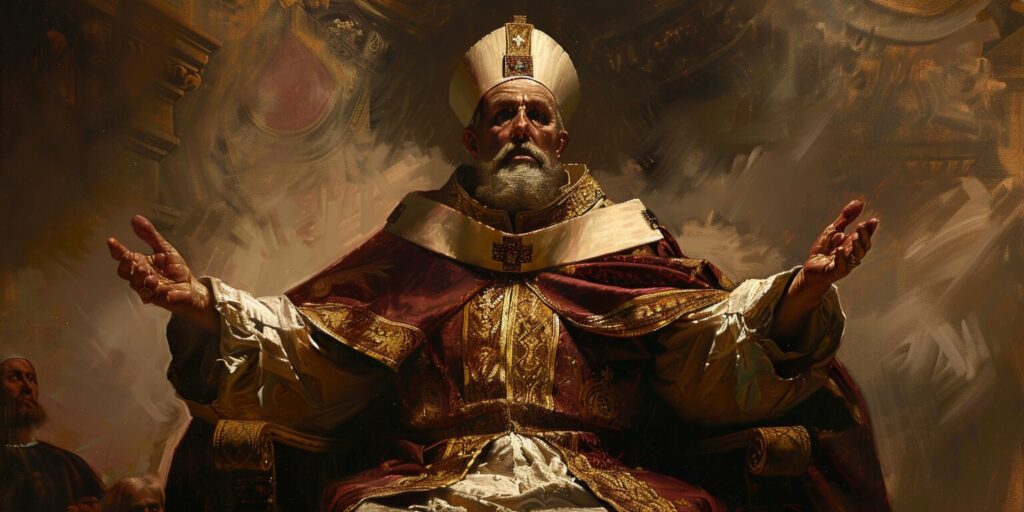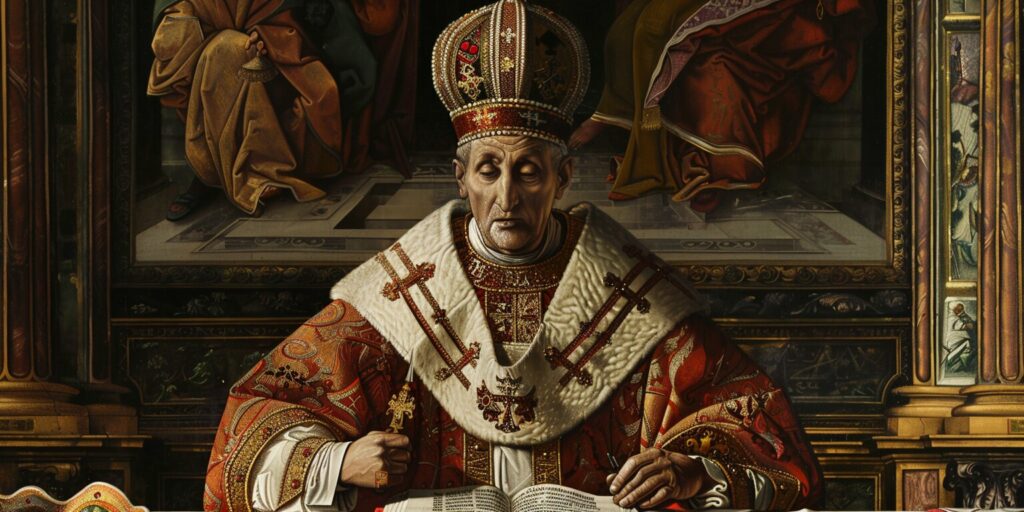Welcome to our exploration of the role of the pope in the Middle Ages and the fascinating history of the medieval papacy. In this article, we will delve into the power and authority of the medieval church leader, the pope, and its profound impact on religious and political spheres. Join us on this journey as we uncover the influential popes of the Middle Ages and shed light on the challenges and controversies they faced. Let’s dive into the rich tapestry of papacy history and discover the pivotal role played by these medieval popes in shaping Western civilization.
The Origins of the Medieval Papacy
In the rich tapestry of medieval church history, the origins of the papacy stand out as a defining characteristic. The medieval popes played a crucial role in shaping the development of the Catholic Church and exerting their influence over religious and political affairs.
The idea of the papacy as a centralized authority with a single leader can be traced back to the early centuries of Christianity. However, during the Middle Ages, the papacy gained significant prominence and power, establishing itself as a key institution in Western Europe.
The medieval church leaders, known as popes, wielded considerable influence over the Christian world. They acted as spiritual guides, arbiters of religious doctrine, and often served as political figures, involved in the affairs of kingdoms and empires.
One influential pope in the Middle Ages was Pope Gregory I, also known as Gregory the Great. He served as pope from 590 to 604 and made significant contributions to the growth of the papacy. Pope Gregory strengthened the papacy’s authority and established it as a major force in the Western world.
Another influential figure was Pope Innocent III, who held the papal office from 1198 to 1216. His pontificate marked a height of papal power and authority, with significant political and religious influence. Pope Innocent III played a key role in shaping the Crusades and asserting the primacy of the papacy over secular rulers.
The Evolution of Papal Power
During the Middle Ages, the papacy consolidated its power by expanding its jurisdiction and asserting its authority over various aspects of religious and secular life. The medieval popes played a crucial role in governing the Church, establishing a hierarchical structure, and implementing canon law.
They also took on the responsibility of appointing bishops and clergy, ensuring the unity and orthodoxy of the Church. This centralization of power gave the papacy a prominent role in the religious and political affairs of the time.
The Influence of the Papacy
The influence of the medieval popes extended far beyond the walls of the Church. They played a pivotal role in shaping medieval Europe’s cultural, social, and political landscape.
The papacy sponsored and supported various artistic and architectural projects, such as constructing magnificent cathedrals and patronizing renowned artists like Giotto and Michelangelo. These endeavors were symbols of the Church’s power and prestige, leaving a lasting legacy on European art and culture.
Furthermore, the medieval popes had a significant impact on politics and diplomacy. They often acted as mediators in conflicts, attempted to unify Christian kingdoms, and influenced the policies of secular rulers. The papacy also played a key role in the formation of alliances, the declaration of wars, and the resolution of disputes.
Ultimately, the origins of the medieval papacy can be traced to the early centuries of Christianity, but it was during the Middle Ages that the institution gained significant prominence and power. The medieval popes, such as Pope Gregory I and Pope Innocent III, were influential figures who shaped the development of the papacy and left a lasting impact on the history of Western civilization.
The Power and Authority of the Medieval Pope
In the Middle Ages, the medieval pope held immense power and authority as the highest leader of the Catholic Church. Their role extended beyond religious matters and significantly impacted both the spiritual and political arenas. Understanding the medieval papal authority is crucial to comprehending the history of the papacy and its influence on medieval society.

As the head of the Church, the medieval pope held the power to make important decisions regarding doctrines, the appointment of bishops, and the interpretation of scripture. Their authority was rooted in the belief that they were the successors of Saint Peter, to whom Jesus Christ had given authority over the Church. This divine connection bestowed upon the pope a level of spiritual significance recognized and respected by clergy and laity.
In addition to their religious authority, the medieval pope wielded strong political influence. They often played significant roles in the affairs of nations, acting as intermediaries and arbitrators in disputes between secular rulers. The pope’s decisions could impact the balance of power within Europe’s kingdoms and influence the course of historical events.
The medieval popes also exerted control over the Catholic Church’s vast wealth and resources. They had the authority to grant land, titles, and privileges, making the papacy a significant economic and political force in medieval Europe. Their ability to bestow favors, appoint bishops, and form alliances with secular powers solidified their position as formidable leaders in both religious and political spheres.
The Papacy’s Influence on Medieval Europe
The medieval pope’s power and authority extended far beyond the walls of the Vatican. They profoundly influenced the everyday lives of individuals and communities throughout Europe. The papal decrees and teachings shaped religious practices, moral codes, and legal systems. Their influence reached into all aspects of society, from the arts and education to international relations.
- The papacy’s involvement in the Crusades and religious wars fought to reclaim the Holy Land showcased the pope’s ability to rally armies and shape the geopolitical climate of the time.
- The medieval pope’s ability to excommunicate individuals or even entire kingdoms demonstrated their power to influence the fate of souls and kingdoms.
- The issuance of papal bulls, official decrees from the pope, had the force of law and could impact the governance and policies of nations.
The medieval pope’s power and authority were not without controversy. Their actions and decisions often faced scrutiny, leading to conflicts with secular rulers and reform movements within the Church. However, the papacy’s influence cannot be understated. It played a central role in shaping medieval Europe’s political, cultural, and religious landscape.
Influential Popes of the Middle Ages
During the Middle Ages, the papacy saw the rise of several influential popes who left an indelible mark on the Church and society as a whole. These popes played pivotal roles in shaping the course of papal history, advancing theological teachings, and navigating the intricate political landscape of the time.

- Pope Gregory I (590-604): Gregory the Great is considered one of the most influential popes in history. During his papacy, he made significant contributions to liturgical reforms, missionary efforts, and charity work. He also wrote extensively on spirituality, leaving behind a rich theological legacy.
- Pope Innocent III (1198-1216): As one of the most powerful medieval popes, Innocent III exerted immense authority over both religious and political matters. He strengthened papal supremacy, initiated the Fourth Crusade, and established the medieval Inquisition. His pontificate left a profound impact on the development of church governance.
- Pope Boniface VIII (1294-1303): Boniface VIII is remembered for his conflict with the French monarchy and for asserting the papacy’s supreme authority over temporal powers. His famous papal bull, Unam Sanctam, declared the pope’s supremacy over secular rulers, illustrating the height of papal power during the medieval era.
- Pope Gregory VII (1073-1085): Gregory VII sought to reform the Church by tackling issues such as simony and clerical celibacy. He clashed with secular rulers, most notably Emperor Henry IV, in the Investiture Controversy, which centered around the appointment of bishops. Gregory’s reform efforts transformed the papacy into a central authority in medieval Europe.
- Pope Urban II (1088-1099): Urban II is renowned for launching the First Crusade. His call for Christians to take up arms and liberate the Holy Land had immense political and religious consequences. The Crusades, initiated during his papacy, would shape the relationship between the papacy and secular powers for centuries to come.
These influential popes of the Middle Ages, among others, secured their place in history through their leadership, reforms, and impact on the Catholic Church and society. Their legacies continue to resonate, shaping our understanding of the medieval papacy and its enduring significance.
Challenges and Controversies within the Medieval Papacy
During the Middle Ages, the medieval popes faced a multitude of challenges and controversies in their role as leaders of the Catholic Church. These issues encompassed various aspects of the papacy, from internal struggles to clashes with secular rulers, all of which left a lasting impact on the history of the papacy and the Catholic Church as a whole.
1. Corruption and Scandals
One of the key challenges that the medieval popes encountered was the presence of corruption and scandals within the Church. Some popes indulged in nepotism, appointing family members to important positions within the hierarchy. This practice often resulted in abuses of power and the prioritization of personal interests over the greater good of the Church.
Furthermore, instances of simony, where positions within the Church were bought and sold, were not uncommon. This undermined the integrity of the papacy and led to a loss of faith among the Catholic faithful.
2. Power Struggles and Schisms
The medieval papacy was not immune to power struggles within the Church and with secular rulers. The struggle for influence and control often led to conflicts between different factions and rival claimants to the papal throne.
These power struggles sometimes resulted in the emergence of rival popes, leading to schisms within the Catholic Church. For example, the Great Western Schism of the 14th and 15th centuries saw multiple individuals claiming the title of pope, dividing the faithful and creating confusion.
3. Conflicts with Secular Rulers
The medieval popes frequently clashed with secular rulers over matters of jurisdiction and authority. The struggle for power between the papacy and kings and emperors often led to strained relations and even open conflict.
Secular rulers sought to assert their own authority over the Church, challenging the pope’s supremacy. This tension between the papacy and secular powers contributed to a complex web of political and religious dynamics that shaped the history of the medieval Catholic Church.
Despite these challenges and controversies, the medieval papacy remained a central institution in the Catholic Church hierarchy, exerting significant influence over religious and political affairs. Understanding the difficulties faced by the medieval popes allows us to gain a deeper appreciation of the papacy’s evolving nature and role within the broader context of papal history.
Conclusion
In conclusion, the role of the pope in the Middle Ages was pivotal in both religious and political spheres. The medieval papacy shaped the Catholic Church’s history and profoundly impacted Western civilization’s development.
Throughout this article, we have delved into the origins of the medieval papacy and explored the power and authority of the popes during this period. We have highlighted influential popes who left a lasting legacy, contributing to theology and influencing society.
Furthermore, we have examined the challenges and controversies faced by the medieval papacy, such as corruption and power struggles. These obstacles shed light on the complexity of the papal institution and its interactions with secular rulers.
By understanding the influence and history of the medieval popes, we gain valuable insights into this significant period of time. The legacy of the medieval papacy continues to resonate, reminding us of the enduring impact of the Church throughout history.

